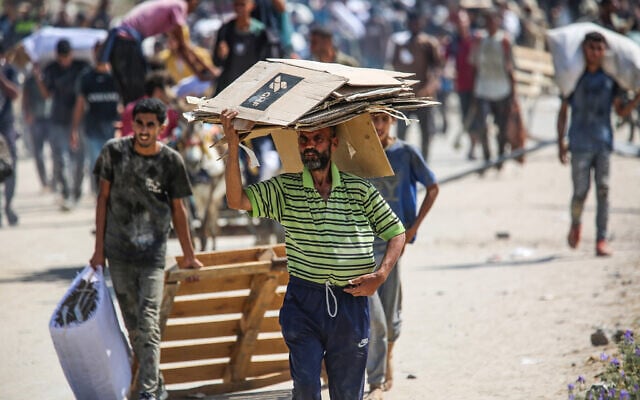



WASHINGTON — US President Donald Trump indicated Tuesday that he would not interfere with Israeli plans to occupy the entirety of the Gaza Strip.
Hours earlier, Prime Minister Benjamin Netanyahu held a security consultation and reportedly came out in favor of the IDF taking control of the entire enclave, even if doing so endangers the lives of the remaining hostages held in areas not yet conquered by the army.
Pressed by reporters at the White House on whether he’d support such a plan — which still needs to receive final approval form the Israeli cabinet later this week — Trump responded, “That’s pretty much going to be up to Israel.”
The US president said his primary focus is on feeding Gazans “who are obviously not doing to well with the food.”
Trump added that “Israel is going to help us with that in terms of distribution and also money.”
He said “Arab states are also going to help us with that in terms of money and possibly distribution.”
Israel has reportedly already funneled millions of dollars to the controversial Gaza Humanitarian Foundation, though it has yet to publicly confirm doing so, as such funding would likely be unpopular among parts of Netanyahu’s right-wing base that opposes allowing aid into Gaza, let alone paying for it.
Already on July 28, as international outcry over reports of mounting hunger in Gaza peaked, Trump announced the US would establish new “food centers” in the enclave, which would be run by Israel.
The announcement surprised many in Jerusalem, who thought the US would back the establishment of additional distribution sites run by the GHF, rather than create a new mechanism.
But on July 29, the White House confirmed that Trump planned to do just that and would be announcing a new Gaza aid plan, which has yet to be rolled out.
On Friday, US special envoy Steve Witkoff and US Ambassador to Israel Mike Huckabee visited a GHF site in southern Gaza. Huckabee hailed GHF’s work after the visit, in a sign that the US would stick to expanding the existing mechanism.
But Witkoff avoided complementing GHF, simply tweeting that the purpose of the visit was to report back to Trump on the humanitarian situation in order to craft a plan to deliver more food to Gazans.
Axios reported on Tuesday that the US wants to significantly increase its role in the distribution of aid, feeling Israel has bungled the issue to date, though, the administration’s exact plan is still being crafted.
US State Department spokesperson Tammy Bruce was also asked Tuesday about a potential Israeli occupation of the entire Strip, but declined to comment.
“We remain focused on freeing the hostages, including the remains of two Americans, and ensuring that Hamas never rules Gaza again,” Bruce said during a State Department briefing, highlighting the recent videos of emaciated Israeli hostages released by Hamas and Palestinian Islamic Jihad.
“What we saw was an astoundingly evil reminder of who they are… For them to feel comfortable putting on full display their barbarity and their inhumanity, tells you that they seem to feel pretty comfortable at the moment,” she added.
Trump was asked later Tuesday whether he had Hamas’s “horrible” video of emaciated Israeli hostage Evyatar David being forced to dig his own grave in the tunnel where he is being held in Gaza.
“I think it’s horrible,” Trump said. “I hope a lot of people do get to see it, as bad as it is, because I think it’s a horrible thing.”
Netanyahu is increasingly convinced that only by entering areas in central and northern Gaza that the IDF has avoided due to fear of harming the hostages, will Israel be able to successfully pressure Hamas to release the remaining captives.
The IDF’s leadership is opposed to the strategy, fearing it could lead Hamas to execute hostages if it senses the army closing in on its operatives.
The manner in which the debate has played out loudly in the press has led to some speculation that talk of potential Israeli occupation is itself a strategy aimed at coaxing Hamas to come back to the negotiation table to finalize a deal that would release 28 of the remaining 50 hostages.
Talks had been progressing over the course of last month before falling apart on the July 24, when the US and Israel pulled their negotiating teams from Doha over frustration with Hamas’s response to the latest truce proposal.
Arab mediators have told The Times of Israel that the gaps are still bridgeable, but Netanyahu’s office has briefed reporters that he now prefers a comprehensive deal to release all of the hostages in exchange for an end to the war.
Hamas has long preferred this framework, but Netanyahu is also demanding that the Islamist terror group give up its weapons and leave the Strip, which are non-starters for Hamas.
Moreover, he believes that military pressure can be used to secure the release of the remaining hostages, an approach that is prone to increasing skepticism as the war enters its 22nd month, and as Israel has yet to articulate a clear exit strategy and plan for who will run the Strip after the war.
Meanwhile, aid groups have been alarmed by the potential for widespread famine in Gaza after Israel blockaded the Strip for 78 days. While assistance has tricked in since the end of May, humanitarian organizations say it has been woefully insufficient.
Much of it has been through GHF, which aid organizations and much of the international community opposes, as it requires Gazans to walk long distances in order to pick up a box of dry food products that need to be prepared elsewhere in the Strip where cooking fuel and equipment is scarce.
While the mechanism was established to try and box Hamas out of the aid process, desperation of hungry Gazans has led to chaotic scenes at GHF sites where thousands of people burst through the entrances each day to grab boxes of food as quickly as possible.
There is no registration process to ensure that Hamas operatives are not among those benefiting from the aid, and stronger segments of the population able to weather the difficult trek to the distribution sites are the primary beneficiaries at the expense of more vulnerable Palestinians most in need of aid.
What has most dominated headlines since the rollout of GHF have been the repeated shootings of those trying to reach their aid sites. The UN says 766 people have been killed in these shootings. While the IDF has been blamed, it insists figures have been inflated, that it only fires warning shots at those who pose a threat and that Hamas operatives and other gunmen are also opening fire at aid seekers from within the crowd.
Scenes around UN convoys have not been much better, with the UN acknowledging that it has been unable to deliver the vast majority of its aid to warehouses and distribution centers throughout the Strip due to looting by mobs of hungry Gazans who are too unsure about where their next meal will be to allow the trucks to pass without overtaking them.
Over the past two weeks, those trying to pounce on these convoys have come under IDF fire, with the UN reporting twice as many shootings in those scenarios as the ones targeting Gazans trying to reach GHF sites.
Israel also accuses Hamas of diverting and profiting off of much of the aid that enters the Strip.
For its part, Israel faults the UN for the breakdown in aid distribution, arguing that the UN has failed in its mandate, and only agrees to intensify its efforts after Jerusalem calls it out. The UN, in turn, insists that Israeli restrictions and the war’s conditions make a sustainable humanitarian operation all but impossible.



